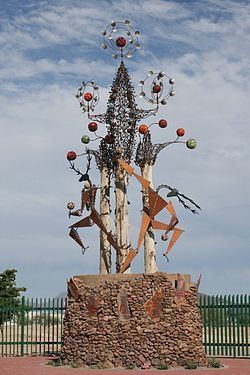Time zone MST (UTC-7) | Area 15,720 km² | |
 | ||
Clubs and Teams Naranjeros de Hermosillo, Cimarrones de Sonora, Soles de Sonora, Búhos de Hermosillo Points of interest Cerro de la Campana, MADERO Park, Catedral de Hermosillo, PARQUE INFANTIL DE HER, Museo de Culturas Populare Colleges and Universities Universidad de Sonora, Instituto Tecnológico de Hermo, Monterrey Institute of Technolo, TecMilenio University - Hermosillo | ||
Hermosillo is a municipality in Sonora in north-western Mexico. The municipal seat is the city of Hermosillo.
Map of Hermosillo, Sonora, Mexico
As municipal seat, the city of Hermosillo is the local government of over 3,800 other localities, with a combined territory of 14,880.2 km2. Other important communities include Miguel Alemán, San Pedro el Saucito, Bahía Kino, La Victoria and La Manga.
The municipality borders the municipalities of Carbó Municipality, San Miguel de Horcasitas Municipality, Ures Municipality, Mazatán Municipality, La Colorada Municipality, Guaymas Municipality and Pitiquito Municipality, with the Gulf of California to the southwest.
The municipality is mostly flat with sloping towards the sea. There are isolated mountain peaks that reach to only 300 meters above sea level and include Tepoaca, Bacoachito, Lopez, Tonuco, Seri, Batamote, Goguz, Bronces, SantaTeresa, La Palma, Siete Cerros and La Campana. These are located mostly in the eastern section of the municipality. The two most important rivers are the Rio Sonora and the Rio San Miguel. Both of these are used for irrigation purposes with the Abelardo L. Rodriguez dam located on the San Miguel River. The population increase of the municipality, currently at 2.5% annually puts pressure on the infrastructure of the city, especially its water supply. Decades of overpumping of ground water has led to the aquifer levels being lower than sea levels, and sea water creeping in as an "artificial recharge."
The municipality is with two arid climate regions. The first is that next to the sea, which is desert with fairly cold winters and hot summers. The rest of the municipality is very dry desert with larger temperature variations than the coastal area. Temperatures can range from as low as freezing in January and February to 48 °C in July and August. Rains for both climates falls mostly between June and September, with annual precipitation between 75 and 300 millimeters, depending on location. Most of the vegetation here consists of mesquite trees as well as trees such as the desert ironwood, palo verde and the huisache. Dune vegetation exists at Bahia de Kino. Desert animals such as the desert tortoise, rattlesnakes, bighorn sheep and lynx are the most notable species.
